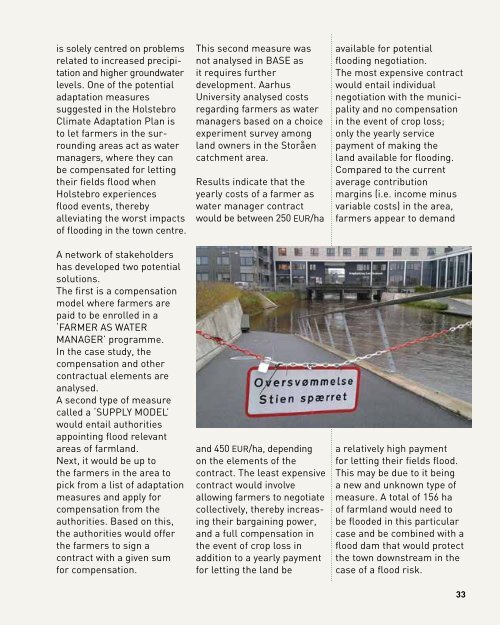BASE_book_RZ_2712_screen
Create successful ePaper yourself
Turn your PDF publications into a flip-book with our unique Google optimized e-Paper software.
is solely centred on problems<br />
related to increased precipitation<br />
and higher groundwater<br />
levels. One of the potential<br />
adaptation measures<br />
suggested in the Holstebro<br />
Climate Adaptation Plan is<br />
to let farmers in the surrounding<br />
areas act as water<br />
managers, where they can<br />
be compensated for letting<br />
their fields flood when<br />
Holstebro experiences<br />
flood events, thereby<br />
alleviating the worst impacts<br />
of flooding in the town centre.<br />
A network of stakeholders<br />
has developed two potential<br />
solutions.<br />
The first is a compensation<br />
model where farmers are<br />
paid to be enrolled in a<br />
‘farmer as water<br />
manager’ programme.<br />
In the case study, the<br />
compensation and other<br />
contractual elements are<br />
analysed.<br />
A second type of measure<br />
called a ‘supply model’<br />
would entail authorities<br />
appointing flood relevant<br />
areas of farmland.<br />
Next, it would be up to<br />
the farmers in the area to<br />
pick from a list of adaptation<br />
measures and apply for<br />
compensation from the<br />
authorities. Based on this,<br />
the authorities would offer<br />
the farmers to sign a<br />
contract with a given sum<br />
for compensation.<br />
This second measure was<br />
not analysed in <strong>BASE</strong> as<br />
it requires further<br />
development. Aarhus<br />
University analysed costs<br />
regarding farmers as water<br />
managers based on a choice<br />
experiment survey among<br />
land owners in the Storåen<br />
catchment area.<br />
Results indicate that the<br />
yearly costs of a farmer as<br />
water manager contract<br />
would be between 250 Eur/ha<br />
and 450 Eur/ha, depending<br />
on the elements of the<br />
contract. The least expensive<br />
contract would involve<br />
allowing farmers to negotiate<br />
collectively, thereby increasing<br />
their bargaining power,<br />
and a full compensation in<br />
the event of crop loss in<br />
addition to a yearly payment<br />
for letting the land be<br />
available for potential<br />
flooding negotiation.<br />
The most expensive contract<br />
would entail individual<br />
negotiation with the municipality<br />
and no compensation<br />
in the event of crop loss;<br />
only the yearly service<br />
payment of making the<br />
land available for flooding.<br />
Compared to the current<br />
average contribution<br />
margins (i.e. income minus<br />
variable costs) in the area,<br />
farmers appear to demand<br />
a relatively high payment<br />
for letting their fields flood.<br />
This may be due to it being<br />
a new and unknown type of<br />
measure. A total of 156 ha<br />
of farmland would need to<br />
be flooded in this particular<br />
case and be combined with a<br />
flood dam that would protect<br />
the town downstream in the<br />
case of a flood risk.<br />
33


